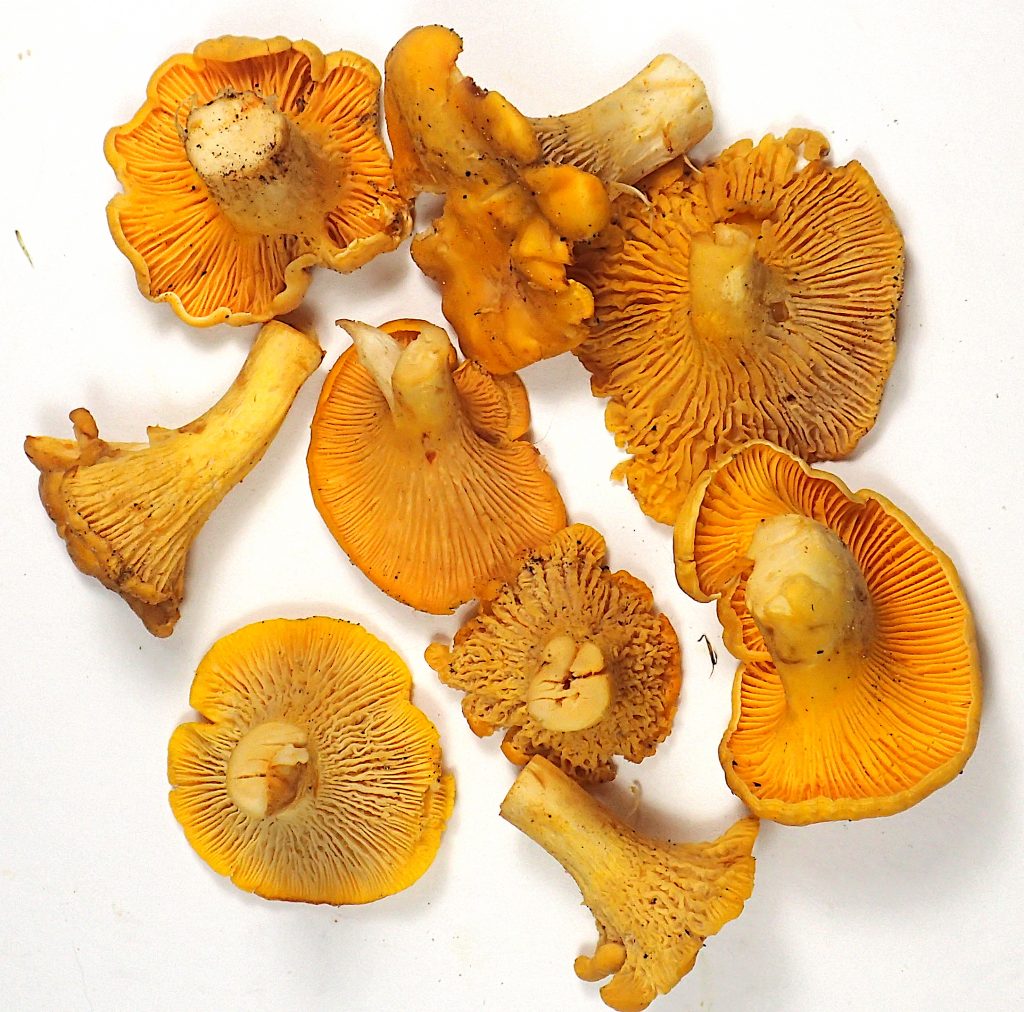
Heavy rains this past week kicked off the mushroom season for the year. Above are chanterelles among the best wild edible mushroom locally. Photo by Green Deane
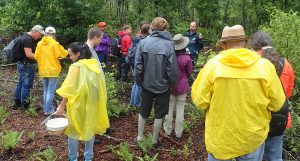
Joshua Buchanan leading OMG’s first mushroom hunt of the season. Photo by Green Deane
The Orlando Mushroom Group (OMG!) met Sunday for their first fungal foray of the year. Despite heavy early rain and threats of a wet day 16 people braved the damp and ticks to hunt mushrooms near Sanford. Among the mushrooms seen or discusses were chanterelles, oysters, wood ears, puffballs, more iffy were Russulas, Agaricus, Lactarius, Lentinus, medicinal Reishi, and a few toxic Amanitas. There are at least 80 edible species of mushrooms in Florida. OMG is the only middle-state mushroom group I know of. Another outing at a different location is planned for late June or early July. It will be announced here or you can join the Orlando Mushroom Group page on facebook (along with Florida Mushroom Identification Forum, Edible Mushroom Florida, and the Southeastern US Mushroom Identification Forum.
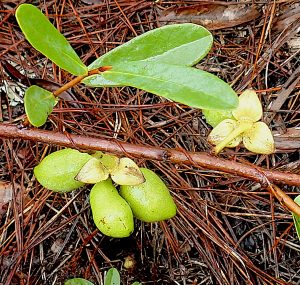
Pawpaw in fruit and blossom. Photo by Green Deane
While scouting for mushrooms we also saw promise of a great season with the Vacciniums, aka, blueberries, huckleberries and deerberries. They have been mentioned several times in recent newsletters. There were enough early ripe ones for a nibble. The only real precaution besides species identification is to watch for Black Bears. Every time I have met a Black Bear in Florida woods it’s been near a patch of ripe Vacciniums. It is their grocery store after all. Black Bears are usually shy and run away but beware of mom and cubs. Also fruiting but more difficult to find ripe were Pawpaws. They, too, are a favorite with denizens of the woods. We found some setting fruit but also some just blossoming which suggests perhaps a long season this year. You can read about Pawpaws here.

Classes are held rain or shine.
Our foraging class in Largo also managed to beat out the Saturday rain. True Thistles were easy to find and comprise a stable for local foragers. First-year roots are tasty raw or cooked. One Eastern Red Bud still has some pods on them but a little too old to eat raw. Several Simpson Stoppers were getting ready to fruit and at least two “Eastern Cedars” had “berries.” The problem, of course, is while we call them “Eastern Cedars” they are really junipers and they don’t have berries but cones. This week I will be making two trips to southeast Florida. I have a Saturday class in Ft. Pierce and a Sunday class in West Palm Beach. Dress for rain!
Saturday, May 26th, George LeStrange Preserve, 4911 Ralls Road, Fort Pierce, FL, 34981. 9 a.m.
Sunday May 27th, Dreher Park, 1200 Southern Blvd., West Palm Beach, 33405. 9 a.m., meet just north of the science center.
Saturday, June 2nd, Red Bug Slough Preserve, 5200 Beneva Road, Sarasota, FL, 34233, 9 a.m.
Sunday June 3rd, Colby-Alderman Park: 1099 Massachusetts Street, Cassadaga. Fla. 9 a.m., meet near the restrooms.
Saturday, June 9th, Blanchard Park, 10501 Jay Blanchard Trail, Orlando, FL 32817. 9 a.m. Meet at the pavilion east of the tennis courts near the YMCA.
Sunday, June 10th, Boulware Springs Park, 3420 SE 15th St., Gainesville, FL 32641. Meet at the picnic tables next to the pump house, 9 a.m.
Saturday, June 16th, Florida State College, south campus, 11901 Beach Blvd., Jacksonville, 32246, 9 a.m.
Sunday, June 17th, Wekiva State Park, 1800 Wekiwa Circle, Apopka, Florida 32712. 9 a.m. Meet at the Sand Lake Parking Lot. This is more wilderness than suburbia so there are more native plants than introduced ones.
To learn more about the classes go here.
 Pregnancy and wild plants. In his book The Green Pharmacy James Duke, PhD, lists several wild edible plants to be avoided while pregnant. They are: juniper berries, mugwort, , mayapple, and evening primrose. Add to them Southern Wax Myrtle as well. There are also quite a few herbs to avoid as well including barberry root, cascara sagradea, feverfew, pokeroot, rue, senna, southernwood, tansy, thuja, mountain mint and St. Johns Wort. Carrot seed, incidentally, should not be consumed if you want to conceive. It has a chemical that prevents fertilized eggs from implanting.
Pregnancy and wild plants. In his book The Green Pharmacy James Duke, PhD, lists several wild edible plants to be avoided while pregnant. They are: juniper berries, mugwort, , mayapple, and evening primrose. Add to them Southern Wax Myrtle as well. There are also quite a few herbs to avoid as well including barberry root, cascara sagradea, feverfew, pokeroot, rue, senna, southernwood, tansy, thuja, mountain mint and St. Johns Wort. Carrot seed, incidentally, should not be consumed if you want to conceive. It has a chemical that prevents fertilized eggs from implanting.

Green Deane Forum
Want to identify a plant? Looking for a foraging reference? Do you have a UFO, an Unidentified Flowering Object you want identified? On the Green Deane Forum we chat about foraging all year. And it’s not just about warm-weather plants or just North American flora. Many nations around the world share common weeds so there’s a lot to talk about. There’s also more than weeds. The reference section has information for foraging around the world. There are also articles on food preservation, and forgotten skills from making bows to fermenting food. One special section is “From the Frightening Mail Bag” where we learn from people’s mistakes. You can join the forum by clicking on the button in the menu line.

Green Deane DVD Set
All of Green Deane’s videos available for free on You Tube. They do have ads on them so every time you watch a Green Deane video I get a quarter of one cent. Four views, one cent. Not exactly a large money-maker but it helps pays for this newsletter. If you want to see the videos without ads and some in slightly better quality you can order the DVD set. It is nine DVDs with 15 videos on each. Many people want their own copy of the videos or they have a slow service and its easier to order then to watch them on-line. They make a good gift for that forager you know. Individual DVDs can also be ordered. You can order them by clicking on the button on the top right of this page or you can go here.
 Donations to upgrade EatTheWeeds.com and fund a book are going well and past 50%. Thank you to all who have contributed to either via the Go Fund Me link, the PayPal donation link or by writing to Green Deane POB 941793 Maitland FL, 32794. The site has been up for a dozen years, has always been free, and went through a couple of difficult upgrades. The most recent upgrades have been paid for, again thank you. Now I’m trying to include more than a year’s worth of newsletter into a new category function. Again, thank you.
Donations to upgrade EatTheWeeds.com and fund a book are going well and past 50%. Thank you to all who have contributed to either via the Go Fund Me link, the PayPal donation link or by writing to Green Deane POB 941793 Maitland FL, 32794. The site has been up for a dozen years, has always been free, and went through a couple of difficult upgrades. The most recent upgrades have been paid for, again thank you. Now I’m trying to include more than a year’s worth of newsletter into a new category function. Again, thank you.
This is weekly issue 305.
If you would like to donate to Eat The Weeds please click here.
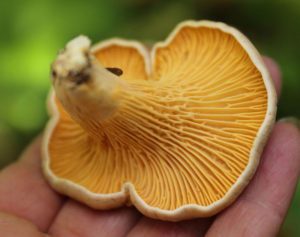
Chanterelles have folds not gills and they have cross bridges. (Look in the middle of the photo.)
Americans inherited a fear of mushrooms from the English. The English are still fungi-phobes but not Europe. A mushroom the British would call “oily” a Ukrainian would call “buttery.” My goal for several years has been to identify the six to one dozen really easy-to-learn local edible mushrooms. Among the easiest and also the tastiest are chanterelles. They can be found from about June to October, maybe even a bit longer than that, and are easy to find and identify. In fact the hardest thing about chanterelles is cleaning them. Ours tend to grow low, we have sandy soil, and rain splatters the grit and debris and chanterelles have a lot of places to collect grit. They don’t have “gills” per se but wrinkles and those wrinkles collect bits of sand and leaf litter. Brushing doesn’t work well — washing’s a no-no — so I’m trying out techniques with my air compressor…
Not only don’t chanterelles have gills but they have cross wrinkles, like little bridges between two shores. That gives one confidence when identifying them. And, the list grows. Recently a new chanterelle was named from Florida. We’ve had one species of pink to red chanterelle, Cantharellus cinnabarinus. I found some under a Hawthorn tree in Ocala, Jervy Gantt Park. But some pink to red ones are also found under Sea Grape trees. They got a new name, Cantharellus coccolobae (named after the Sea Grape genus) and they taste good, too. This morning, in fact, I had an omelet made with freshly picked chanterelles, butter, a little sand for texture and a few bits of oak leaf for mystery.

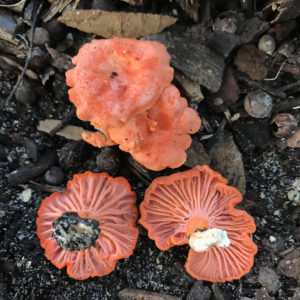

This is very interesting post on the mushrooms. Had never heard of them before now. Wish I could find them where I live. It would be great if every week you would showcase an edible mushroom.
Thanks for caring about pregnant women like formal medicinal prescreptions do . Apart from wild edibles and herbs, I may go to the extreme side of the matter to advise people in general and particularly my preg. Suanese women to keep far away from the poisonous herb – Datura or Jimson weed – as just breathing the air near this plant is fatal . On the other hand, our preg. women here feel joyful and happy just on being close to certain plants , e.g. Date Palm or ” Sidr ” trees .
I would love to get some of those paw paw seeds!
I need a snail mail address.